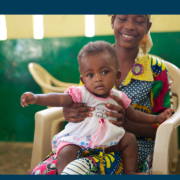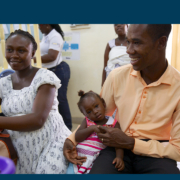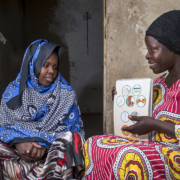Accelerating Family Planning Demand Through Advanced Audience Segmentation
Written by: Cori Fordham, Breakthrough ACTION Program Officer
Effective social and behavior change (SBC) strategies start with a strong understanding of their audiences. SBC practitioners use a process called segmentation to analyze and divide a large audience into smaller groups of people—or segments—that have similar needs, values, or characteristics. It recognizes that different groups may not respond the same way to SBC messages and interventions and that to motivate change, messages should be developed with a group’s specific traits in mind.
Traditionally, audience segmentation in SBC has focused on dividing subgroups based on the demographic, geographic, psychographic, or attributional characteristics that are perceived to be significant in predicting behavioral outcomes. However, projects such as the USAID-funded Transform/PHARE project have begun to apply advanced methods of audience segmentation, adapted from marketing science, to identify the audiences and strategies with the greatest potential impact on family planning outcomes. The results of these advanced methods of data analysis and interpretation provide information for decision-makers to identify the most significant driver of behavior among their audience, predict the approaches that will produce the greatest change, and strategize around the most promising opportunities for resource allocation.
In an effort to document the lessons learned from advanced audience segmentation, Breakthrough ACTION held a webinar and Springboard discussion on Accelerating Family Planning Demand through Advanced Audience Segmentation on Thursday, June 21, 2018. The webinar featured three presentations from groups that have used this process to gain a deeper understanding of their audience’s family planning wants and needs.
First, Jessica Vandermark, Senior Marketing Advisor, Breakthrough ACTION walked through the innovative “national demand analysis” process that Camber Collective piloted in Niger in 2013. This process involves several steps including landscape analysis, supply and demand analysis, segmentation, recommendations and toolkit development, forecasting, and action planning. This approach is particularly useful when developing strategies to accelerate progress, needing to predict future trends and use, effectively coordinating many partners activities to serve a heterogeneous population, and prioritizing limited resources.
Next, Luis Fernando Martinez, Social and Behavior Change Communication Senior Technical Advisor, Transform/PHARE, discussed his experience using the national demand analysis in Côte d’Ivoire. The Transform/PHARE project adapted the national demand analysis piloted in Niger to gain a deeper understanding of their target audience, spark family planning demand to meet their FP2020 goals, and develop recommendations about how to best allocate resources. The team identified the most significant drivers of family planning adoption, life stages, and audience reasons for adopting family planning (avoidance, control/mastery, and spacing/limiting) and developed six segments of women based on these characteristics. Ultimately, the team prioritized three segments: Pre-Family Women, Family Aspirationals, and Family Limiters.
Following Luis, Jessica built on the Côte d’Ivoire experiences Luis shared by explaining how these findings were integrated into an Ivorian SBCC Strategy. Camber Collective also used this process in Burkina Faso and Togo.
Jessica and Luis shared several insights gained from their experiences in Niger and Côte d’Ivoire. Some of these lessons include:
- Results of the national demand analysis have debunked the thinking that family planning need is the greatest predictor of demand or adoption. Camber Collective has seen that family planning is an incredibly personal topic, and a person’s wants, values, and life stage may be more of a motivator than need.
- Program designers and decision-makers should resist the desire to reach everyone at once (a strategy often encouraged by the public sector). It may be more effective to focus efforts on those who are more likely to change their behavior, knowing that a greater improvement in one population could result in positive social norms which could impact other populations. It is also possible to implement a separate targeted campaign if needed.
- Stakeholder engagement at all stages of the analysis was critical to obtaining buy-in and ensuring that findings were integrated into strategies and program activities. Segments and recommendations were reviewed and validated by government officials and implementing partners.
- Results of segmentation assessments are incredibly country specific. Segments in Burkina Faso, Togo, and Niger were rooted in attitudes and behaviors, whereas Ivorian women’s varied by life stages.
The webinar is a part of a package that Breakthrough ACTION created to capture the process and experiences of advanced audience segmentation. The package includes a Trending Topic, How-To Guide, and Adobe Spark page. The Advancing Family Planning Demand through Innovative Audience Segmentation Trending Topic is a curated web page that features tools and program examples. The Advanced Audience Segmentation for SBC How-to Guide outlines step-by-step guidance through the process of background research, in-depth qualitative research, quantitative research, and advanced statistical analysis to create a representative base of audience segments. Lastly, the Accelerating Advanced Audience Segmentation Adobe Spark page captures the process and outputs of Transform/PHARE’s family planning demand analysis and male segmentation analysis in Niger; the Animas-Sutura Project’s experience piloting segment-based counseling tools in Niger; and the work of AgirPF to incorporate the results of a national demand analysis in Cote d’Ivoire into an evidence-based SBC strategy.

 Cambey Mikush/Photoshare
Cambey Mikush/Photoshare Sohel Parvez Haque
Sohel Parvez Haque Sara Holbak/VectorWorks/Photoshare
Sara Holbak/VectorWorks/Photoshare Sarah Hoibak/VectorWorks/Photoshare
Sarah Hoibak/VectorWorks/Photoshare Getty Images/Image of Empowerment
Getty Images/Image of Empowerment © 2012 CCP/NURHI 2, Courtesy of Photoshare
© 2012 CCP/NURHI 2, Courtesy of Photoshare Jonathan Torgovnik/Getty Images/Images of Empowerment
Jonathan Torgovnik/Getty Images/Images of Empowerment